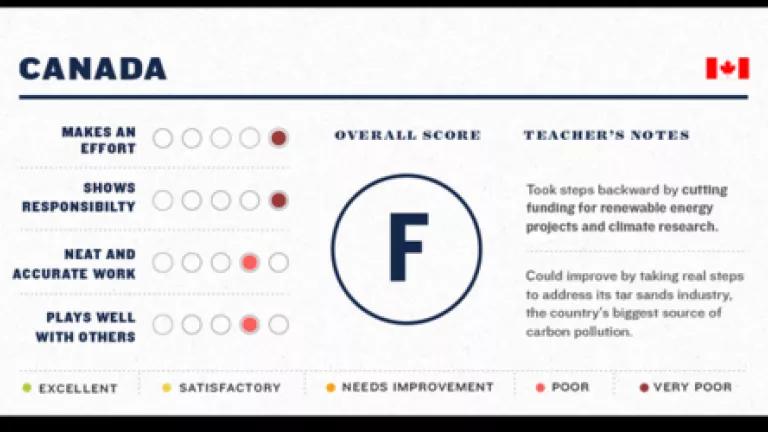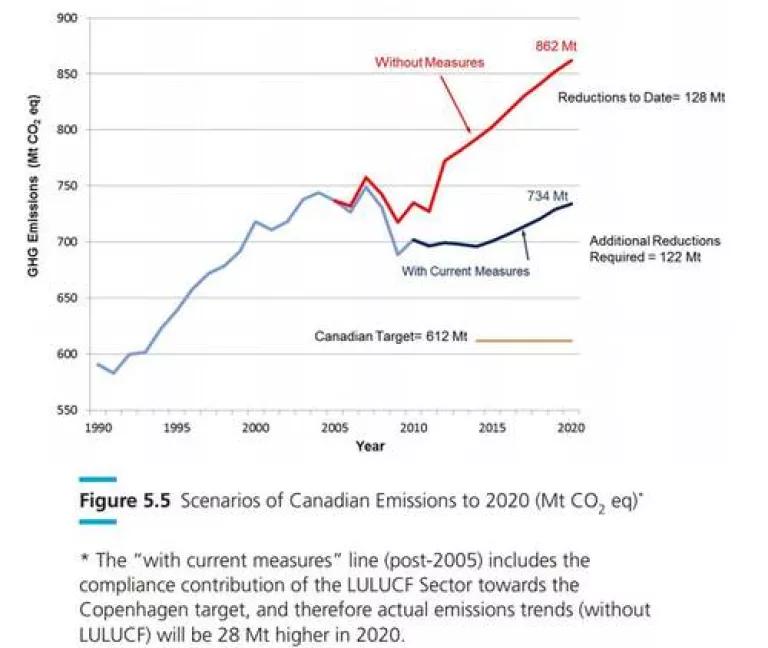
Countries accounting for more than ninety percent of the world's emissions have announced new climate actions in preparation for the Paris agreement to be adopted this December. But not all of those climate action plans deserve a passing grade. In fact, we've given "climate grades" to a number of countries and some of those countries received failing grades. Unfortunately Canada received an "F" for its climate plan.
Canada received an "F" for three reasons (see here for an overview of our grading system).
Reason #1: Inaction on their largest source of carbon pollution - tar sands.
While emissions from conventional crude oil production and natural gas production and processing are expected to fall by 2020, tar sands emissions are growing rapidly and are expected to continue to do so, as my colleague noted (see figure). By 2020, tar sands emissions are expected to be nearly three times the level in 2005 according to the Government of Canada's Sixth National Report on Climate Change. Canada's rapidly growing tar sands emissions (enabled in part by existing and proposed pipelines like Keystone XL tar sands pipeline) will continue to be a barrier to Canada meeting its international climate promises.

Although the Canadian government announced a series of new measures as part of its post-2020 targets, it still failed to address the largest source of emissions growth, tar sands. Instead, the Canadian government has aggressively promoted unchecked tar sands expansion.
For these reasons Canada received a ranking of very poor for "makes an effort" and poor for "plays well with others" in our climate grades.
Reason #2: Failure to implement a serious national action plan to reduce emissions
In 2009, Canada committed to a target at the Copenhagen climate summit of reducing emissions by 17 percent below 2005 levels by 2020. Unfortunately, even with current climate mitigation measures in place, emissions are expected to grow between now and 2020, missing the 2020 target by a wide margin--thanks in large part to tar sands oil production. An independent analysis by Climate Action Tracker indicates that Canada's current policies will lead to a rise in emissions from 2020 through 2030. And even the Government of Canada's own analysis shows that it is only expected to meet half of its Copenhagen pledge with current measures (see figure). Even worse, Canada's emissions continue to increase.
For this reason it gets a very poor for "makes an effort" in our climate grades.
Canada's Progress towards 2020 target (MtCO2e)

Reason #3: Target for Paris climate agreement is too weak
In 2009, Prime Minister Harper pledged with other leaders at the G8 meeting to cut carbon emissions 80 percent by 2050. Earlier this year Canada announced its post-2020 target in preparation for the Paris climate agreement to be adopted this December. Canada announced that it would reduce its greenhouse gas emissions 30 percent below 2005 levels by 2030. The announced target does not put Canada on an ambitious trajectory, and certainly not a trajectory to reach the 80 percent cut by 2050, as my colleague has previously discussed. The target also breaks from past precedent, when Canada "harmonized" its climate target with that of the U.S. If Canada were to harmonize with the U.S. target for 2025, then that would mean a target of 26-28 percent below 2005 levels by 2025.
In addition, Canada's target could include the purchase of emissions reductions from other countries and yet the rules they envision using for these offsets is unclear. And Canada's accounting of the land-use sector hasn't always been what the atmosphere sees.
For these reasons Canada received a very poor in "shows responsibility" and poor in "neat and accurate" in our climate grades.
New government has a chance to turn failure into a solid passing grade. The newly elected national government of Canada has a chance to get a much better grade (see my colleagues post for more details). The criteria are simple: make an effort to implement a policy to significantly constrain tar sands production and associated emissions, implement a set of national and provincial policies to meet your current climate targets, and step-up your effort by committing to a more aggressive climate target as a part of the Paris agreement.
It will take hard work, but we are confident that you have the capability to get a solid passing climate grade.

